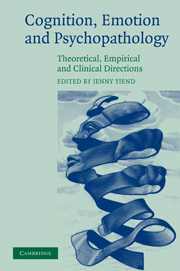Book contents
- Frontmatter
- Contents
- List of contributors
- An introduction and synthesis
- Andrew Mathews: a brief history of a clinical scientist
- Part I Theoretical approaches
- 1 The positive and negative consequences of worry in the aetiology of generalized anxiety disorder: a learning theory perspective
- 2 Trait anxiety, repressors and cognitive biases
- 3 A cognitive-motivational perspective on the processing of threat information and anxiety
- 4 Maintenance or capture of attention in anxiety-related biases?
- Part II Empirical directions
- Part III Clinical perspectives
- Index
1 - The positive and negative consequences of worry in the aetiology of generalized anxiety disorder: a learning theory perspective
Published online by Cambridge University Press: 23 November 2009
- Frontmatter
- Contents
- List of contributors
- An introduction and synthesis
- Andrew Mathews: a brief history of a clinical scientist
- Part I Theoretical approaches
- 1 The positive and negative consequences of worry in the aetiology of generalized anxiety disorder: a learning theory perspective
- 2 Trait anxiety, repressors and cognitive biases
- 3 A cognitive-motivational perspective on the processing of threat information and anxiety
- 4 Maintenance or capture of attention in anxiety-related biases?
- Part II Empirical directions
- Part III Clinical perspectives
- Index
Summary
Two very important lines of work in the past twenty years have contributed substantially to our understanding of many factors involved in the aetiology and maintenance of generalized anxiety disorder (GAD). One of these lines of work was initiated by the pioneering studies of Andrew Mathews, Colin MacLeod and their colleagues in the mid-1980s on individuals with GAD. In numerous studies, such individuals have demonstrated prominent automatic attentional biases for threatening information, and interpretive biases for ambiguous information that could be threatening or non-threatening (see Mathews & MacLeod, 1994; Mineka, Rafaeli & Yovel, 2003; Williams et al., 1997). It is now known that such biases seem to serve as vulnerability factors for anxiety during periods of stress and to serve a likely role in the maintenance of anxiety once it has developed (e.g. MacLeod et al., this volume; Mathews & MacLeod, 2002).
The other line of work contributing substantially to our understanding of GAD was that initiated by Borkovec and his colleagues in the mid-1980s on the nature, functions and consequences of the worry process, which is seen as so central to current formulations of GAD. Worry is often considered to be the primary cognitive component of anxiety and Borkovec's work has focused on understanding why worry is so excessive and persistent in individuals with GAD. Mathews (1990) published an important and widely cited paper linking these two lines of research by arguing that worry functions to maintain hypervigilance to threatening cues. Borkovec and colleagues (Borkovec, Alcaine & Behar, in press) have also linked these two lines of work by noting that the attentional and interpretive biases for threatening information that are shown by generally anxious individuals seem to provide further sources of input or triggers for the worry process.
- Type
- Chapter
- Information
- Cognition, Emotion and PsychopathologyTheoretical, Empirical and Clinical Directions, pp. 29 - 48Publisher: Cambridge University PressPrint publication year: 2004
- 6
- Cited by



